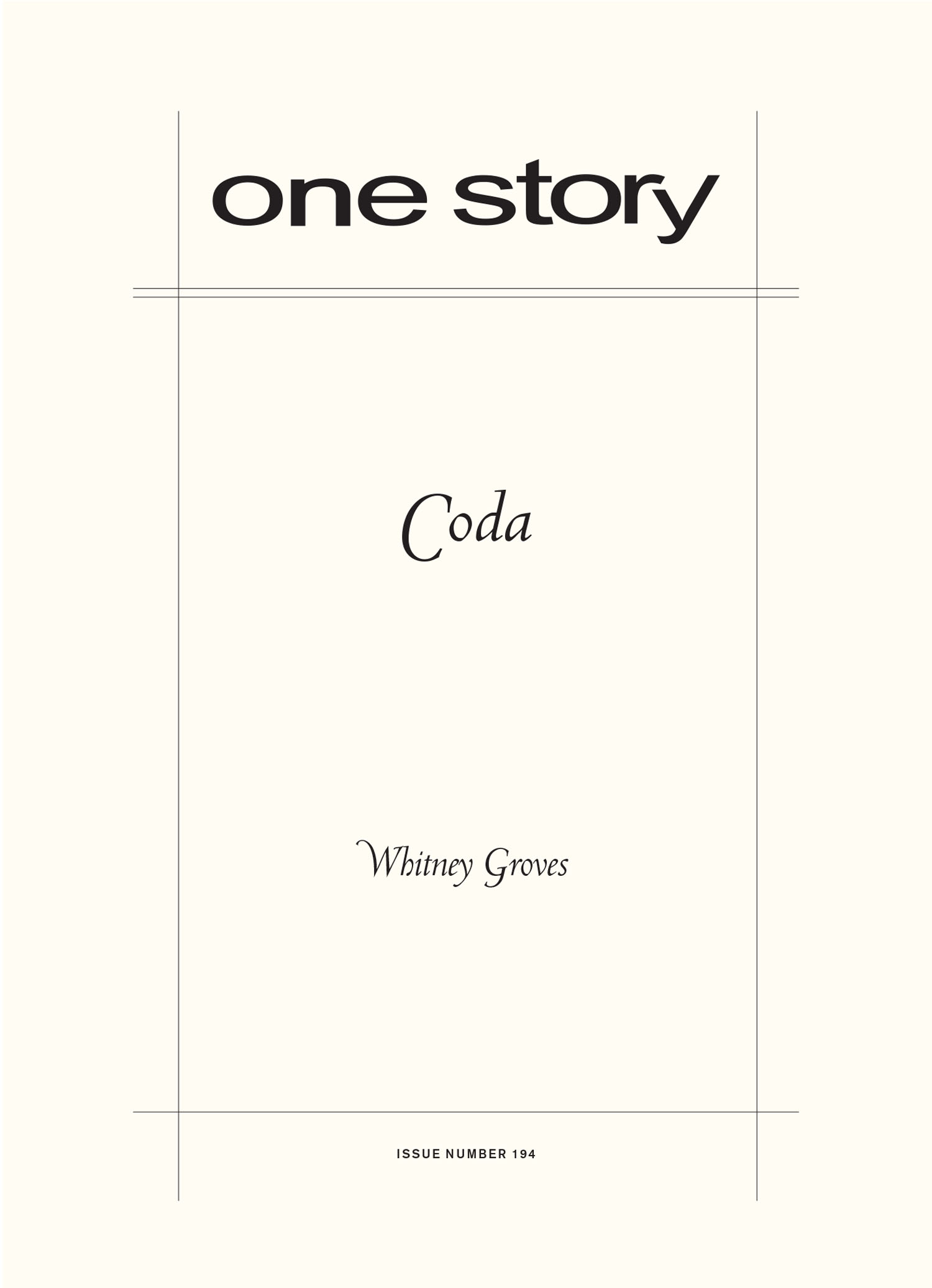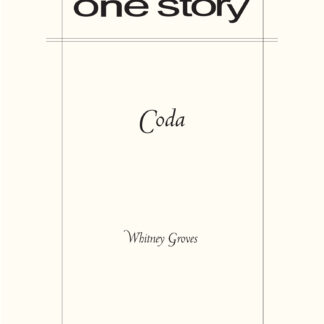
Coda
$2.50
80 in stock
Excerpt
When the nurse leaves, my father pulls down his oxygen mask and says, “Tell me something you remember from before.”
I don’t have to ask before what. I’m getting used to this type of conversation, in which I mentally fill in his blanks. My high school piano teacher used to say that in music, the rests were as meaningful as the notes. The same is true of my father.
“I was three,” I say. “I don’t remember much.”
“Remember the playground? Couple blocks from the house. You loved the spiral slide.”
“I think so.” I remember liking slides, anyway.
A bony hand waves me toward him. “Can’t hear you from over there. Damn machines…too loud.”
I’ve been standing at the window overlooking the parking lot, watching for the arrival of the maroon minivan carrying his wife, Tabitha, and their kids. Today is the first time I’ve seen my father since last summer. Now I sit in the chair beside his bed, surrounded by the mechanical beeping and whirring of the machines that manage his bodily functions. The sounds resonate in the clinical emptiness of the room.
“You wouldn’t eat anything but Cheerios for a while,” he says. “Your second word was Daddy.”
Whitney Groves
Whitney Groves is a high school English teacher. She holds an MFA from Vermont College of Fine Arts and a BA from the University of Richmond. Her nonfiction has appeared in The Georgia Review. Whitney, her husband, and their dog live in the Charlotte, North Carolina area. This is her first published story.
Karen Friedman on “Coda”
A father’s love is supposed to be a transcendent thing, unconditional, reliable and protective, reminiscent of a reasonably priced Subaru. The iconography of fatherhood is used to sell us everything from sodas to appliances. But as we all know, reality rarely emulates the ideal. So what happens when the paternal relationship is nothing more than a loose tether? Our latest issue, “Coda”, by debut author Whitney Groves explores one such father-daughter relationship. The main character, Vera, has spent the majority of her life knowing very little about her father — hazy memories and scraps of information provided by a reluctant mother. The story alternates between Vera’s final encounter with her father and the moments that brought Vera to a reconciliation with the man who abandoned her sixteen years earlier. “Coda” is a quiet story about what remains when a relationship falls short of even modest expectations. As an editor, I am struck by Vera’s measured response to her father. Anger would have been the easy route. Instead, Vera’s journey is one of longing mostly endured. Groves fills that longing with tension and, most surprisingly, humor. By bringing the reader close to Vera, we understand her desire at the most basic human level to be seen and validated by her father, to be loved by a man she has never known. It is an honor to introduce Whitney Groves to all of you in her first published piece of fiction. For more on how Whitney developed this beautiful and heartbreaking story please check out our author Q&A.
Q&A by Karen Friedman
- KF: Where did the idea for this story come from?
- WG: The basic trajectory of Vera and Rusty’s story mirrors my own relationship with my father. Like Vera, I thought that meeting my dad would be a healing experience. He was more honest with me than Rusty was with Vera, but we never connected as deeply as I’d hoped we would. When he died, I had to deal with the knowledge that the emptiness created by his absence during my childhood would never go away. My response — several years after the fact — was to write about it. I wanted to address the idea that time doesn’t, in fact, heal all wounds. An individual may remain emotionally and spiritually moored to a certain event, even as it recedes into the past. The good news is, it’s possible to acknowledge that event as a part of one’s present with grace and courage, not remorse.
- KF: The relationship between Vera and her father, Rusty, is striking for its simultaneous intimacy and sense of alienation. Despite years apart, Vera is able to fill in his silences, and yet in the most basic ways they do not know each other. How did you arrive at that level of complexity? Was it there from the start?
- WG: I think it was there from the start. I heard the opening sentence all of a piece in my mind, and I wrote it down immediately and never changed it. That style of conversation seemed the best way to show the dynamic between Rusty and Vera: neither wants to jeopardize their superficial connection — it might be the only connection they ever have. That’s one reason why Vera is good at filling in his silences. Plus, she’s spent her whole life attuning herself to others’ needs. She engages in a sort of reverse manipulation to meet her own needs for information, approval, emotional harmony, etc.
- KF: What was the most challenging aspect of writing this story?
- WG: The hardest part was knowing what to tell and what to leave out. It’s one of my perennial problems as a writer, but it was even more challenging with “Coda.” Because the story is loosely based on my life, I could imagine decades of experience that made Rusty, Vera, and Lauren who they were. But I also recognized that the gaps in understanding, for both the characters and the reader, were essential to creating the resonance I wanted. Finding that balance proved to be a crucial (read lengthy and difficult) learning experience for me.
- KF: Music is integral to the way Vera relates to the world. At what point in the writing process did you realize Vera was a musician and did it alter the way you approached her as a character?
- WG: I don’t remember consciously deciding that Vera would be a musician. Classical musicians need to be almost fanatically disciplined, but they also need the ability to access profound passions. That apparent contradiction has always fascinated me. It seemed to describe Vera’s internal conflict pretty effectively. In the first draft, though, I didn’t have Vera and Rusty listening to jazz together. During the revision stage, I expanded the role of music throughout the story, with the result that Vera became somewhat less passive. Of course, her actions are still calculated to gain Rusty’s approval, but her effort to use music strategically made her a more complex character.
- KF: One of the first words you used when describing your story to me was “fractal”, which I remember thinking described it pretty darn well. How do you think structure works to enhance this story? And was playing with form something you set out to do?
- WG: When I started working on “Coda,” I’d just read Amy Hempel’s “In the Cemetery Where Al Jolson is Buried.” That story was a revelation to me: I’d had no idea that structure could pack such an emotional wallop. It gave me the courage to try a nonlinear before-during-after structure with “Coda.” I figured out immediately that the during part would be Rusty and Vera’s last conversation. Other than that, the “fractality” developed largely on its own. As you know, fractals are repeating patterns that occur in nature in some weirdly awesome ways. The same structural pattern can occur at a macro level, such as the pattern of a tree’s branches, and also at the micro level, with its individual leaves. With those images in mind, I wanted “Coda” to use time, not space, as the scale on which Vera’s patterns of behavior repeat themselves.
- KF: The flash-forward near the end of the story is one of my favorite scenes. Without giving away too much, why was it important to you as an author to take your readers there?
- WG: In keeping with the idea that a single moment can resonate backward and forward in time, I wanted the readers to see what Vera does with the knowledge she gains from Rusty. The flash-forward challenges the idea that closure is possible. It also gives her the opportunity to vary the pattern she’s been living out for twenty years.
- KF: What are you working on now?
- WG: I’m working on a novel in stories, set at a truck stop in west Texas. Many of the characters are less educated and have a narrower experience of life than did Rusty and Vera, so it’s a challenge to address complex ideas while staying faithful to the characters’ voices. Like “Coda,” though, connections and patterns seem to be emerging, whether or not I create them intentionally. That’s the great mystery of the writing process, I guess.
- KF: What is the best bit of advice about writing you have ever received?
- WG: Tough question! In the last few years, I’ve been blessed with several outstanding teachers who’ve helped me develop my craft and my confidence. Two of them are Clint McCown and David Jauss, both of whom advised me to write the sentences, scenes, and stories that move me. This may seem like common sense, but I don’t always do it. It’s easy for an apprentice writer to get caught up in her own (real or perceived) cleverness, or to write a story the way it “should” be according to someone else’s construct. I’m grateful to Dave and Clint for encouraging me to trust my own imagination and aesthetic sense. Maybe one of these days, I’ll be able to do it consistently.
